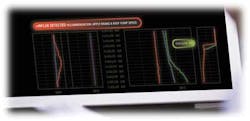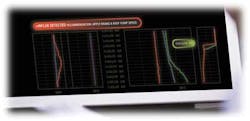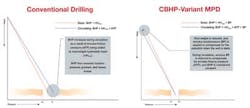Brian Grayson
Essam Sammat
Weatherford
Closed-loop circulating systems are proving to be the watershed technology for a new and quickly expanding set of deepwater wellbore construction capabilities. By enabling the precise, real-time monitoring and management of wellbore pressure, these fluid circulating systems provide the basis for new ways of understanding and affecting wellbore pressures.
They are the basis for a palate of managed pressure drilling (MPD) method s that are solving complex drilling challenges. And they open the door for new technologies that are further enhancing deepwater drilling capabilities where conventional drilling methods have proven risky, costly, or simply inadequate.
Opening the door
"Closing the loop" refers to a process that circulates drilling fluid within a contained, pressurizable system. This closed-loop contrasts with conventional drilling circulating systems that are open to the atmosphere.
The loop is closed by a rotating circulation device (RCD) placed atop the BOP on a land application and, in a recent advance, integrated below the tension ring as part of the marine riser system. The RCD contains and redirects the annular flow away from the rig floor to an automated MPD choke manifold.
Within this closed loop, changes in pressure are easily detected and effected. Pressure and mass flow measurements provide real-time data that informs changes in choke settings to manipulate annular backpressure at the surface, which immediately increases or decreases downhole wellbore pressure. The result is an ability to understand and manage downhole pressure.
The various MPD methodologies that have evolved from this ability have been further enabled and enhanced by the development of specialized software to monitor, analyze and control wellbore pressure. One of these, the constant bottomhole pressure (CBHP) method, is a particular advantage in deepwater wells where precise wellbore pressure control is required to drill narrow windows between pore pressure and fracture gradient.
The ability of CBHP methods to dial-in and hold a specific downhole pressure without changing mud weight provides a high degree of control and a new first-response to an influx or kick. The mud option is still there, but backpressure can be applied very precisely and long before a mud response can be implemented.
While conventional well control capabilities remain fully functional, MPD enables a response that may preclude their use, and certainly provides the data for a more informed well control response. This improves safety and reduces the risks and costs associated with fighting kick/loss cycles, wellbore instability, stuck pipe, and other pressure-related problems.
Precise detection and management of pressure also provides the means to mitigate riser gas, a problem unique to deepwater drilling. Riser gas occurs when a gas influx entrained in an oil-based mud breaks out of solution as it is circulated to the surface. This typically occurs about 2,000 to 3,000 ft (610 to 914 m) below the drill floor. At this point, the gas is above the BOP in the riser and beyond conventional containment.
The standard mitigation practice is to vent the gas using the rig diverter system. However, this affords minimal control and presents considerable risk. With an MPD system, the expanding gas is quickly detected, SBP is applied, and the gas is circulated out to the mud gas separater (MGS). Continuous containment is maintained.
Closed-loop systems also provide a basis for developing and applying new technologies that further enhance the well construction process. For example, the addition of a special circulating device to allow for continuous circulation made up in the drillstring is helping manage pressure by mitigating swabbing effects. Advanced gas detection systems used in MPD operations are being used identify kicks and control the breakout of dissolved gas from the mud.
Drilling offshore Ghana
MPD is achieving remarkable successes in well construction applications that have been impossible using conventional methods. In less extreme applications, the technology greatly reduces risk and improves efficiency. In both cases, it helps extend the scope of deepwater prospects around the world.
An example of drilling "the impossible" is a pair of wells in the deepwater offshore Ghana, West Africa. Where conventional drilling failed in two attempts due to pressure-related wellbore problems, MPD operations successfully mitigated the instability and kicks. The well was not only drilled successfully, it was drilled deeper than planned and without incident.
The first of the two wells encountered an inherently unstable rubble zone, and sharp pore pressure and fracture gradient changes. The wellbore was side tracked, and ultimately plugged and abandoned in the 12¼-in. section.
There were no indications of high pore pressure while drilling the main wellbore, but blocky cuttings at the surface suggested changes in mechanical stress and stability. A rubble zone was identified as the source of the cuttings.
In the rubble zone, the well packed off several times due to sloughing shale and no progress was made in drilling the main wellbore. A side track attempted to penetrate the rubble zone using a higher mud weight to prevent sloughing. It encountered less resistance and formation sloughing until a drilling break was encountered and an influx of 16 to 20 bbl led to shutting in the wellbore.
About four years later, drillers returned for another attempt in the rubble. The prior experience had led to the selection of a MPD system to control wellbore pressures and stability at a new level of precision.
The change led to successful drilling of the well. The 14¾-in. section was vertically drilled to roughly 12,000 ft (3,657m), which was 532 ft (162 m) deeper than the planned objective. The additional hole allowed the 133⁄8-in casing shoe to be set deeper, eliminating the need for the 105⁄8-in. section and reducing non-productive time.
In drilling the MPD well, operations were enhanced by the operator's proprietary circulating technology, a dual valve sub made up in the drillstring to allow continuous circulation. This has several benefits, including simplifying pressure management when making connections, cooling the hole, and continuous monitoring of drilling gas during connections.
MPD application
The MPD application was preceded by engineering studies that included kick simulations to identify the pressure limits of the drilling equipment. Establishing the limits ensures the pressure capability needed to safely circulate an influx. Key considerations include loads on the casing shoe, choke line, RCD, riser, and mud-gas systems (MGS). One response was to increase the slip-joint/riser pressure limit to 1,000 psi to ensure that the MPD operations could circulate gas out of the riser.
These pressure considerations benefited from the inclusion of an innovative marine RCD. The device achieves two key results: the rig retains use of its existing telescopic riser joint (slip joint) to achieve maximum stroke and compensate for rig movement in harsh sea conditions; and the maximum pressure rating of the riser can be used in managing wellbore pressure.
In drilling the well, the application of SBP was effective in controlling the annular pressure profile and managing bottomhole pressure fluctuations. Applying 170 psi of annular pressure to the wellbore while pulling out of the hole maintained stability and helped prevent swabbing effects from causing an influx. In addition, real-time pore pressure/fracture pressure data was acquired by testing upper and lower limits while drilling, saving time and costs.
The well was drilled without borehole stability issues, underreaming or contingency liners. Riser gas breaking out of the oil-based mud was routinely identified and handled. The success of the drilling operation proved that MPD is an effective solution to the rubble zone challenge.
Gas detection
Accurate understanding of the gas coming out of the formation is critical; when combined with the precise flow metering capability of a MPD system, advanced gas extraction and analysis technology provides insights that improve safety and efficiency.
The Weatherford gas extraction and analysis system uses membrane technology and a high-speed gas chromatograph to monitor gases as they arrive at the surface. The small unit is placed downstream of the choke but upstream of the degasser to acquire a gas sample that is representative of downhole conditions. Most in-field gas measurement solutions extract a gas sample from drilling mud after it has passed through the degasser, which limits the accuracy of the analysis.
Tests were conducted to validate the system's ability to detect and analyze gas in the mud in conjunction with MPD operations. During circulation of an influx, data from the gas detection system helped to plan the strategy for handling the gas at the surface. System data was also used to control the breakout of dissolved gas from oil-based mud by varying SBP through the automated chokes. This critical capability ensures that gases containing hydrocarbons are handled safely on the surface.
The gas system also provided quantitative analysis of the lighter and hence more volatile hydrocarbon components, so that circulation rates and SBP can be used to mitigate hazards.
Early kick detection using MPD is also enhanced with the addition of gas detection and analysis. An operator in the North Sea is successfully applying the surface gas detector with MPD to drill a complex field consisting of mature, depleted sections of the reservoir commingled with sections that are still charged with geopressure.
The method leverages real-time gas analysis with the MPD system's capability to control kicks or losses to improve drilling safety and efficiency. If an influx is detected, the driller is notified and makes appropriate corrections. The gas analysis is so sensitive that it can help the driller ensure that they are applying the optimal downhole pressure at all times.
The gas detection tool does not operate in isolation, but rather complements the data obtained from other surface logging tools that measure flow, fluid density and pressure. Any change observed in one instrument is verified by another instrument.
The fact that these readings compliment and effectively crosscheck each other provides confidence in the data for better-informed decision-making.
Offshore Articles Archives
View Oil and Gas Articles on PennEnergy.com





